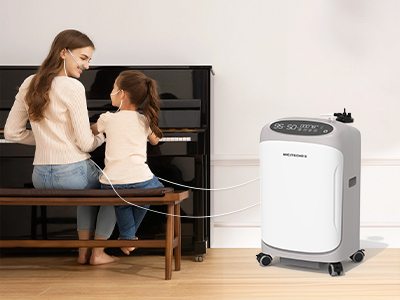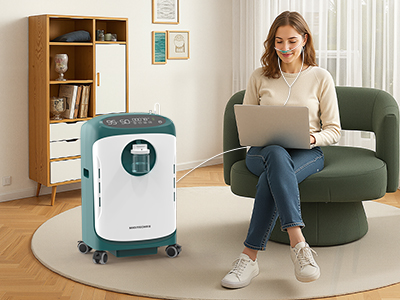21 Jul 2025
Let’s face it—breathing is one of those things we tend to take for granted. That is, until it turns into a labored, wheezy, puff-and-huff kind of ordeal. Enter the oxygen concentrator: the unsung hero of pulmonary support. This mighty machine doesn’t just pump out air; it’s a precision tool that, when used at the right moments, can elevate quality of life, prevent complications, and—let’s be honest—keep the drama to a minimum.
So, when exactly is the right time to turn on the concentrator and let the O₂ flow like a finely aged wine? Let’s dive in, lungs first.

Understanding What an Oxygen Concentrator Really Does
Imagine a magical box that takes ordinary air, sifts through it like a picky eater, and serves up a purified stream of delicious oxygen. That’s basically your concentrator. It removes nitrogen from the air and delivers a higher concentration of oxygen—typically 90–95% pure—to your respiratory system.
Unlike tanks, it doesn't run out unless your power does. Think of it as a never-ending oxygen buffet—on tap, on demand, and entirely unflavored.
When Your Blood Oxygen Drops Below the “Oh No” Zone
Your blood oxygen saturation level (SpO₂) should ideally hang out around 95–100%. If it drops below 90%, your organs start to whisper, “Help…”—and then scream.
Signs It’s Time:
You’re feeling like you’ve just run a marathon after walking to the fridge.
Your lips or fingernails turn a delicate shade of Smurf-blue.
You have a pulse oximeter reading that dips under 88% while resting.
A concentrator can swoop in and keep your organs happily oxygenated without making you feel like you’ve swallowed a balloon.
During Respiratory Illness or Infection
Whether it's a chest cold, a bout of pneumonia, or the latest flavor of flu, respiratory infections can temporarily reduce your lungs' ability to suck in and distribute oxygen. This is when your concentrator becomes your bodyguard.
Oxygen to the Rescue:
Reduces shortness of breath.
Helps your body fight off infection without going into oxygen debt.
Prevents that oh-so-fun trip to the emergency room.
The key? Don’t wait until you're wheezing like an accordion at a polka festival. Early intervention wins.
While Sleeping (Because Yes, Breathing Matters Then Too)
Nighttime is when your body goes into repair mode—but if oxygen levels drop while you're snuggled under your weighted blanket, that repair process gets cut short.
Who Needs It at Night?
People with sleep apnea + low SpO₂.
Individuals with chronic lung disease
Those who wake up feeling like they’ve run laps in their dreams
Sleep should feel like recharging your battery, not depleting it. An oxygen concentrator at night can help you wake up feeling like a slightly more radiant version of yourself.
During Physical Activity (Even Mild Stuff Like Folding Laundry)
When It’s Worth Plugging In:
You’re out of breath before your dog is.
Your muscles ache after minimal exertion.
You avoid activity altogether to prevent that awful winded feeling.
Using oxygen during exertion ensures your tissues aren’t being starved. Because no one should need a full intermission after putting on pants.
As Prescribed for Chronic Conditions
Some conditions come with a permanent RSVP to Team Oxygen. This includes:
COPD (Chronic Obstructive Pulmonary Disease)
Pulmonary fibrosis
Severe asthma
Congenital heart defects
Post-COVID lung damage (our new villain)
Doctors don’t prescribe oxygen therapy just for giggles. It’s meant to improve your day-to-day, prevent hospitalizations, and reduce strain on your heart. Consistency is key—don’t treat your concentrator like a needy houseplant. Use it as prescribed.

Not-So-Great Times to Use an Oxygen Concentrator
Even the best things in life come with disclaimers. Like cheese. Or glitter.
Times to Be Cautious:
Near open flames or while smoking (oxygen + fire = Darwin Award).
While using oil-based products (no petroleum jelly near that cannula, please).
If you feel overly drowsy or dizzy—your oxygen might be too high.
More is not always better. Be Goldilocks about it—aim for just right.
Making the Most of Your Machine
You’ve got the gear. You know the signs. Now let’s optimize.
Pro Tips:
Use a humidifier attachment if your nose feels like the Sahara.
Clean the filter regularly to avoid inhaling a cocktail of dust and cat hair.
Don’t coil your tubing like a snake. Let it breathe, too.
Travel concentrators are available if your wanderlust competes with your lung function.
Oxygen therapy isn’t just about surviving—it’s about thriving with mechanical elegance.
Keywords: oxygen concentrator
Originally published 21 Jul 2025, updated 21 Jul 2025.